When it comes to feeding a crowd, one of the most common questions is how much pasta to make per person. It can be difficult to determine the right amount, especially if you have a partially used package of pasta. But fear not! We have gathered information from various sources to provide you with a comprehensive guide on how much pasta to feed a crowd.

Key Takeaways
- The recommended serving size for pasta is two ounces of dry pasta per person.
- Plan for about one cup of cooked pasta per four people.
- Different pasta shapes require different amounts of dry pasta, so refer to a handy chart for specific measurements.
- Consider the sauce-to-pasta ratio, with 1 ½ cups of sauce for every pound of pasta for tomato-based sauces and one cup of sauce per pound of pasta for oil-based sauces.
- Properly preparing the pasta and sauce involves reserving pasta water, adding fat, and mixing well for a creamy and well-coated dish.
- Additional tips and tricks include pairing pasta with complementary sauces, saving pasta water as a thickening agent for sauce, and adding a pinch of sugar to balance out the acidity in tomato-based sauces.
Determining Pasta Serving Sizes for Different Types of Pasta
When it comes to feeding a crowd, one of the most common questions is how much pasta to make per person. According to the USDA, a single serving size of pasta is typically about two ounces of dry pasta, which amounts to about a cup of cooked pasta. However, this serving size may be a bit small, especially for hearty eaters. To ensure you have enough pasta for everyone, it’s recommended to plan for about one cup per four people. So if you’re serving a group of eight, you would need approximately two cups of dry pasta.
But how much dry pasta does that entail? Fortunately, we have a handy chart that breaks it down for you. The chart provides the uncooked amount per person for various types of pasta, including:
| Pasta Type | Dry Pasta Amount per Person | Cooked Pasta Amount per Person |
|---|---|---|
| Long Pasta: | 2 ounces dry pasta = 1/2 inch diameter bundle | 1 cup cooked pasta |
| Short Pasta: | 2 ounces dry pasta = 1/2 cup | 1 cup cooked pasta |
| Small Pasta: | 2 ounces dry pasta = 1/3 cup | 3/4 cup cooked pasta |
| Filled Pasta: | 2 ounces dry pasta = 9-12 pieces | 1 1/4 cups cooked pasta |
| Fresh Pasta: | 2 ounces fresh pasta = 1/4 cup | 1 cup cooked pasta |
It’s important to note that different pasta shapes vary in size, so it’s essential to adjust the quantities accordingly based on the type of pasta you’re using. For example, for angel hair pasta, you would need two ounces per person, while for elbow macaroni, you would need half a cup or two ounces per person.
How Much Pasta (Dry) to Cook: A Handy Chart
When it comes to feeding a crowd, one of the most common questions is how much pasta to make per person. It can be difficult to determine the right amount, especially if you have a partially used package of pasta. But how much dry pasta does that entail? Fortunately, we have a handy chart that breaks it down for you.
| Pasta Type | Uncooked Amount Per Person |
|---|---|
| Angel Hair | 2 ounces |
| Bow Tie | 1/2 cup or 2 ounces |
| Egg Noodle | 1/2 cup or 2 ounces |
| Elbow Macaroni | 1/2 cup or 2 ounces |
| Fettuccine | 2 ounces |
| Linguine | 2 ounces |
| Medium Shell | 1/2 cup or 2 ounces |
| Rigatoni | 1/2 cup or 2 ounces |
| Rotini | 1/2 cup or 2 ounces |
| Spaghetti | 2 ounces |
| Thin Spaghetti | 2 ounces |
| Vermicelli | 2 ounces |
| Ziti | 1/2 cup or 2 ounces |
It’s important to note that different pasta shapes vary in size, so it’s essential to adjust the quantities accordingly based on the type of pasta you’re using.
Now that you have an idea of how much dry pasta to cook, you can confidently prepare pasta for any crowd size. Just remember to adjust the quantities based on the type of pasta being used.
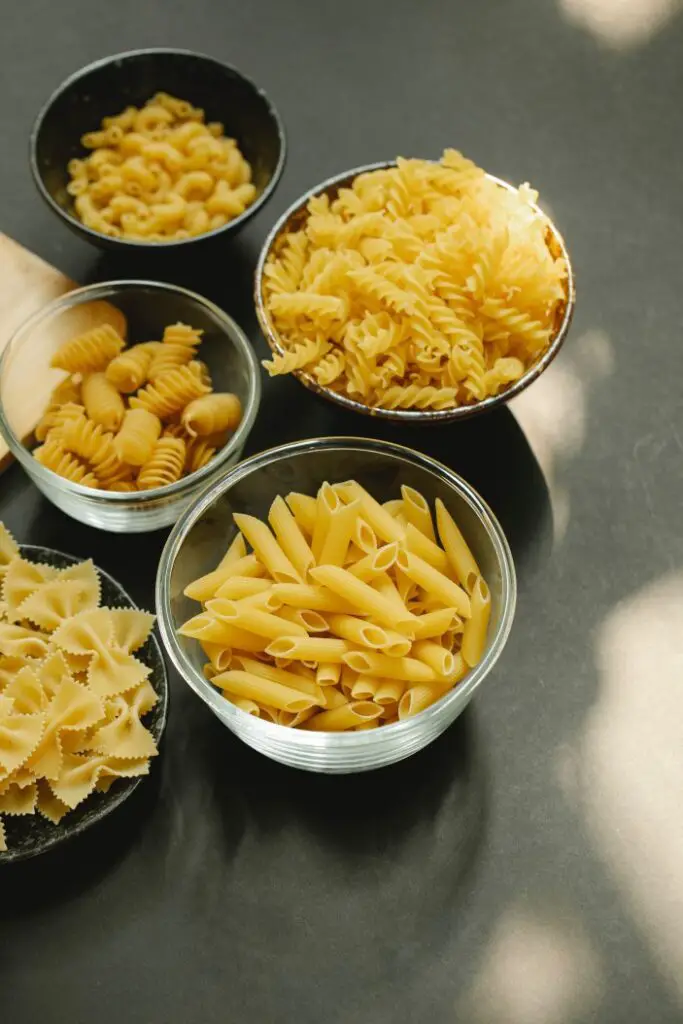
How Much Pasta (Dry) to Cook for a Crowd: A Handy Chart
| Number of People | Long Pasta | Short Pasta | Small Pasta | Filled Pasta | Fresh Pasta |
|---|---|---|---|---|---|
| 1 | 2 oz | 2 oz | 2 oz | 2 oz | 2 oz |
| 5 | 10 oz | 10 oz | 10 oz | 10 oz | 10 oz |
| 10 | 20 oz (1.25 lb) | 20 oz (1.25 lb) | 20 oz (1.25 lb) | 20 oz (1.25 lb) | 20 oz (1.25 lb) |
| 15 | 30 oz (1.87 lb) | 30 oz (1.87 lb) | 30 oz (1.87 lb) | 30 oz (1.87 lb) | 30 oz (1.87 lb) |
| 20 | 40 oz (2.5 lb) | 40 oz (2.5 lb) | 40 oz (2.5 lb) | 40 oz (2.5 lb) | 40 oz (2.5 lb) |
| 25 | 50 oz (3.12 lb) | 50 oz (3.12 lb) | 50 oz (3.12 lb) | 50 oz (3.12 lb) | 50 oz (3.12 lb) |
| 30 | 60 oz (3.75 lb) | 60 oz (3.75 lb) | 60 oz (3.75 lb) | 60 oz (3.75 lb) | 60 oz (3.75 lb) |
| 35 | 70 oz (4.37 lb) | 70 oz (4.37 lb) | 70 oz (4.37 lb) | 70 oz (4.37 lb) | 70 oz (4.37 lb) |
| 40 | 80 oz (5 lb) | 80 oz (5 lb) | 80 oz (5 lb) | 80 oz (5 lb) | 80 oz (5 lb) |
| 45 | 90 oz (5.62 lb) | 90 oz (5.62 lb) | 90 oz (5.62 lb) | 90 oz (5.62 lb) | 90 oz (5.62 lb) |
| 50 | 100 oz (6.25 lb) | 100 oz (6.25 lb) | 100 oz (6.25 lb) | 100 oz (6.25 lb) | 100 oz (6.25 lb) |
| 75 | 150 oz (9.37 lb) | 150 oz (9.37 lb) | 150 oz (9.37 lb) | 150 oz (9.37 lb) | 150 oz (9.37 lb) |
| 100 | 200 oz (12.5 lb) | 200 oz (12.5 lb) | 200 oz (12.5 lb) | 200 oz (12.5 lb) | 200 oz (12.5 lb) |
| 200 | 400 oz (25 lb) | 400 oz (25 lb) | 400 oz (25 lb) | 400 oz (25 lb) | 400 oz (25 lb) |
How Much Pasta (Cooked) to Serve a Crowd: A Handy Guide
| Number of People | Long Pasta | Short Pasta | Small Pasta | Filled Pasta | Fresh Pasta |
|---|---|---|---|---|---|
| 1 | 1 cup | 1 cup | 3/4 cup | 1 1/4 cups | 1 cup |
| 5 | 5 cups | 5 cups | 3 3/4 cups | 6 1/4 cups | 5 cups |
| 10 | 10 cups | 10 cups | 7 1/2 cups | 12 1/2 cups | 10 cups |
| 15 | 15 cups | 15 cups | 11 1/4 cups | 18 3/4 cups | 15 cups |
| 20 | 20 cups | 20 cups | 15 cups | 25 cups | 20 cups |
| 25 | 25 cups | 25 cups | 18 3/4 cups | 31 1/4 cups | 25 cups |
| 30 | 30 cups | 30 cups | 22 1/2 cups | 37 1/2 cups | 30 cups |
| 35 | 35 cups | 35 cups | 26 1/4 cups | 43 3/4 cups | 35 cups |
| 40 | 40 cups | 40 cups | 30 cups | 50 cups | 40 cups |
| 45 | 45 cups | 45 cups | 33 3/4 cups | 56 1/4 cups | 45 cups |
| 50 | 50 cups | 50 cups | 37 1/2 cups | 62 1/2 cups | 50 cups |
| 75 | 75 cups | 75 cups | 56 1/4 cups | 93 3/4 cups | 75 cups |
| 100 | 100 cups | 100 cups | 75 cups | 125 cups | 100 cups |
| 200 | 200 cups | 200 cups | 150 cups | 250 cups | 200 cups |
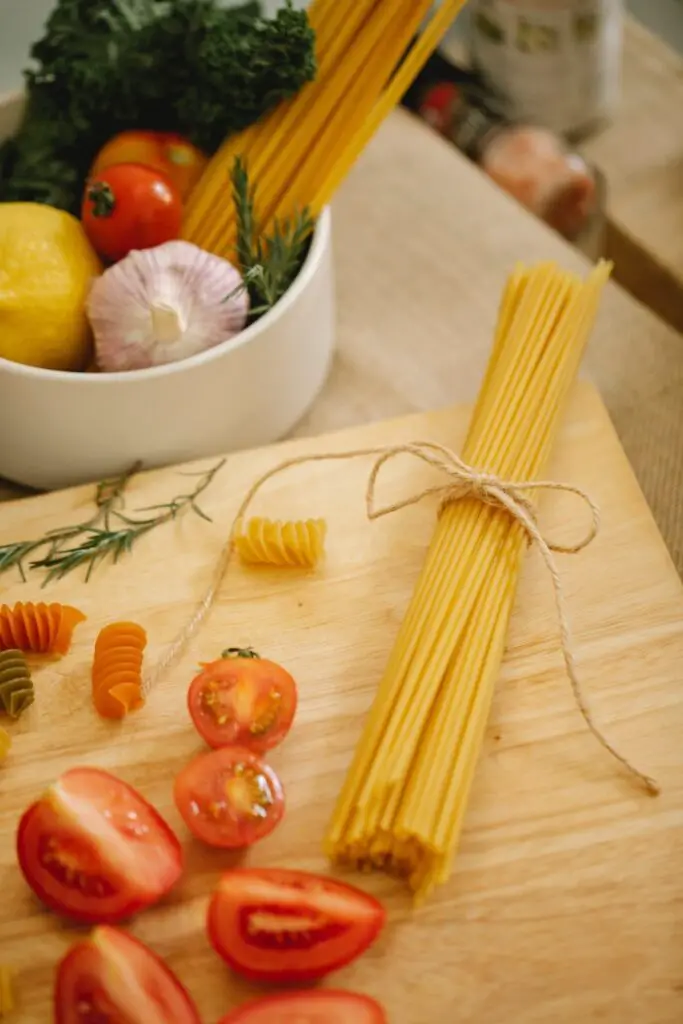
Finding the Right Sauce-to-Pasta Ratio
Now that you have an idea of how much dry pasta to cook, what about the sauce? The sauce-to-pasta ratio is another important factor to consider. For tomato-based sauces, a good rule of thumb is to use about 1 ½ cups of sauce for every pound of pasta. This ratio ensures a balanced coating of sauce without drowning the pasta.
Oil-based sauces like pesto can be used more sparingly, typically requiring about one cup of sauce per pound of pasta. Creamy and rich sauces like Alfredo should also be used in moderation, so it’s best to start with a smaller amount and adjust to your taste.
- Tomato-based sauce: Typically, you’d use about 1/2 cup of tomato-based sauce per serving (2 ounces of dry pasta).
- Cream-based sauce: These sauces are often richer, so you might use slightly less, say 1/3 cup per serving.
- Oil-based sauce: These are even lighter and are often just used to coat the pasta, so let’s assume about 1/4 cup per serving.
By finding the right sauce-to-pasta ratio, you can ensure a well-coated and flavorful dish.
How Much Pasta and Sauce to Serve a Crowd: A Handy Guide
| Number of People | Amount of Dry Pasta | Amount of Tomato-based Sauce | Amount of Cream-based Sauce | Amount of Oil-based Sauce |
|---|---|---|---|---|
| 1 | 2 oz | 1/2 cup | 1/3 cup | 1/4 cup |
| 5 | 10 oz | 2 1/2 cups | 1 2/3 cups | 1 1/4 cups |
| 10 | 20 oz (1.25 lb) | 5 cups | 3 1/3 cups | 2 1/2 cups |
| 15 | 30 oz (1.87 lb) | 7 1/2 cups | 5 cups | 3 3/4 cups |
| 20 | 40 oz (2.5 lb) | 10 cups | 6 2/3 cups | 5 cups |
| 25 | 50 oz (3.12 lb) | 12 1/2 cups | 8 1/3 cups | 6 1/4 cups |
| 30 | 60 oz (3.75 lb) | 15 cups | 10 cups | 7 1/2 cups |
| 35 | 70 oz (4.37 lb) | 17 1/2 cups | 11 2/3 cups | 8 3/4 cups |
| 40 | 80 oz (5 lb) | 20 cups | 13 1/3 cups | 10 cups |
| 45 | 90 oz (5.62 lb) | 22 1/2 cups | 15 cups | 11 1/4 cups |
| 50 | 100 oz (6.25 lb) | 25 cups | 16 2/3 cups | 12 1/2 cups |
| 75 | 150 oz (9.37 lb) | 37 1/2 cups | 25 cups | 18 3/4 cups |
| 100 | 200 oz (12.5 lb) | 50 cups | 33 1/3 cups | 25 cups |
| 200 | 400 oz (25 lb) | 100 cups | 66 2/3 cups | 50 cups |
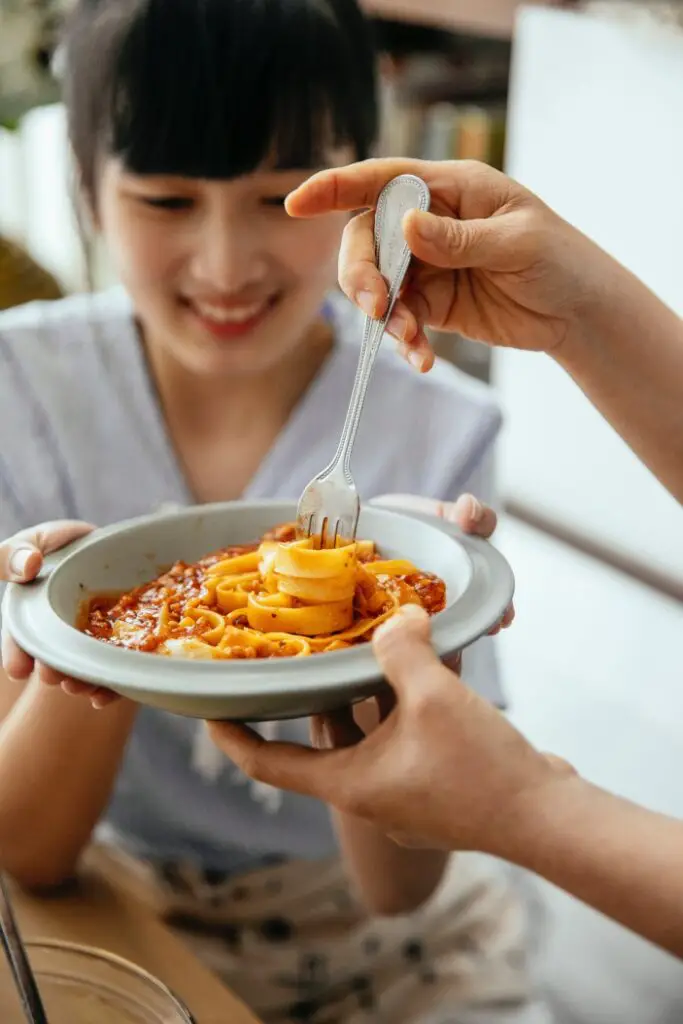
Preparing the Perfect Pasta and Sauce Combination
When it comes to preparing the pasta and sauce, there is a proper technique to ensure a perfect combination. Firstly, cook the pasta according to the package instructions. While the pasta is cooking, heat the sauce in a large pan until warm.
Once the pasta is cooked, drain it, reserving about half a cup of pasta water. The starch from the cooking water helps the sauce adhere to the pasta. Then, add the pasta to the warmed sauce and add a small amount of fat, such as butter or cream, to help the sauce coat the noodles. Start with a quarter cup of reserved pasta water and mix well. This will create a creamy and well-coated pasta dish.
It’s essential to mix the pasta and sauce well so that every bite is adequately coated. This ensures a flavorful and satisfying dish that will impress any crowd.
Don’t forget to reserve some of the pasta water as it can be added to the sauce to adjust the consistency as needed. Additionally, using the reserved pasta water as a thickening agent is a great way to add flavor and depth to your dish.
Following these steps will help you achieve the perfect pasta and sauce combination. Remember to start with a smaller amount of sauce and add more as needed to create a well-balanced dish.
Now that you have the basics down, it’s time to experiment with different types of pasta and sauces to find your perfect combination. Don’t be afraid to get creative and try new things.
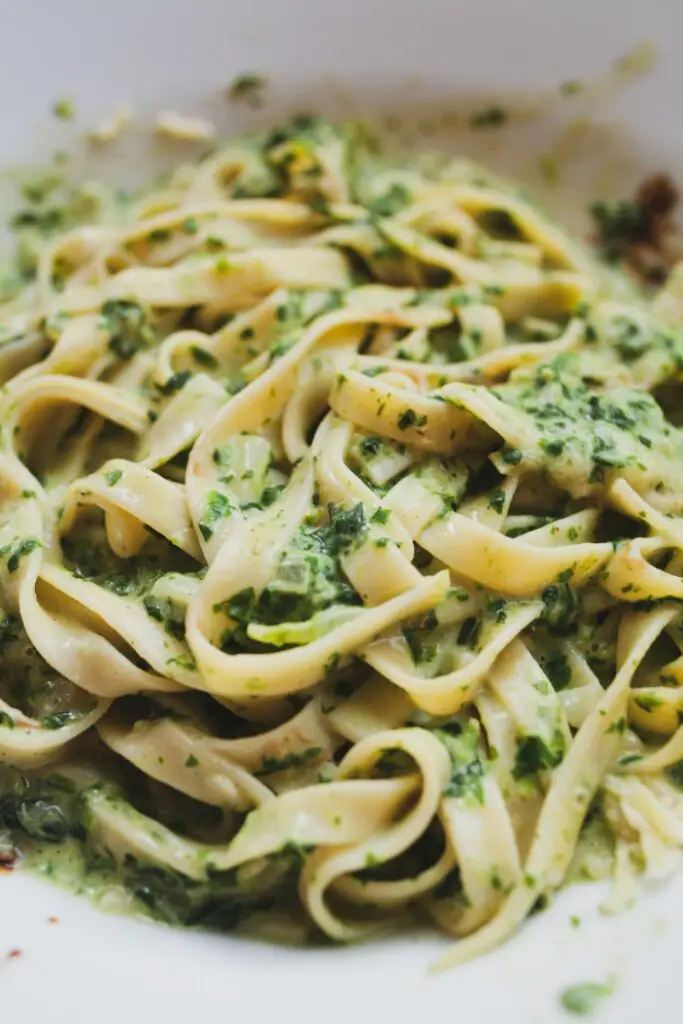
Additional Tips and Tricks for Pasta Preparation
Now that you have all the information on how much pasta to feed a crowd, it’s time to consider some additional tips and tricks. Freezing any leftover cooked pasta is possible, just make sure to freeze the pasta and sauce separately to maintain the best quality.
Additionally, consider pairing your pasta with complementary sauces. Heavier sauces, like Alfredo, work best with wider noodles like fettuccine, while thinner sauces are perfect for skinnier noodle shapes like angel hair.
Remember to save your pasta water as well, as it can act as a thickening agent for pasta sauce. Pour it over the cooked noodles before adding the sauce for added flavor and texture.
Don’t forget to try adding a pinch of sugar to pasta sauce as well to mellow out any acidity and create a more balanced sauce.
As mentioned earlier, it’s important to adjust the quantities based on the type of pasta being used. Don’t be afraid to experiment with different shapes and sauce combinations to find the perfect match for your taste preferences.
To thicken a sauce, add a bit of flour or cornstarch after sautéing any vegetables or meat. Mix well before adding any liquid ingredients and simmer until the sauce reaches the desired thickness.
Overall, pasta can be a versatile and tasty meal option for feeding a crowd. By following these tips and tricks, you’ll be well on your way to creating delicious pasta dishes that everyone will enjoy.
How Much Pasta Should I Make to Feed a Large Group?
When determining the macaroni and cheese serving size for a large group, plan for 1 cup per person. For a side dish, plan for 1/2 cup per person. It’s always better to have extra than not enough, so consider making a little more to account for hungry guests.
Conclusion
In conclusion, determining how much pasta to feed a crowd depends on the number of people you’re serving and their individual appetites. The general guideline is to allow for about one cup of cooked pasta per four people, with the specific amount of dry pasta varying based on the type of pasta you’re using. And don’t forget to consider the sauce-to-pasta ratio for a well-coated and flavorful dish.
Now that you have all the information you need, you can confidently prepare pasta for any crowd size. Remember to use the handy chart we provided to determine the appropriate amount of dry pasta to cook per person and adjust accordingly based on the type of pasta you’re using. And when it comes to the sauce, follow the guidelines we outlined to ensure a balanced and well-coated dish.
With these tips and tricks, you’ll be able to create delicious pasta dishes that are sure to be a crowd-pleaser. And don’t forget to experiment with different types of pasta and sauces to find your perfect combination. Whether it’s a family dinner or a large gathering, you’ll have all the knowledge you need to prepare the perfect amount of pasta for your guests. So go forth and enjoy your delicious pasta creations!
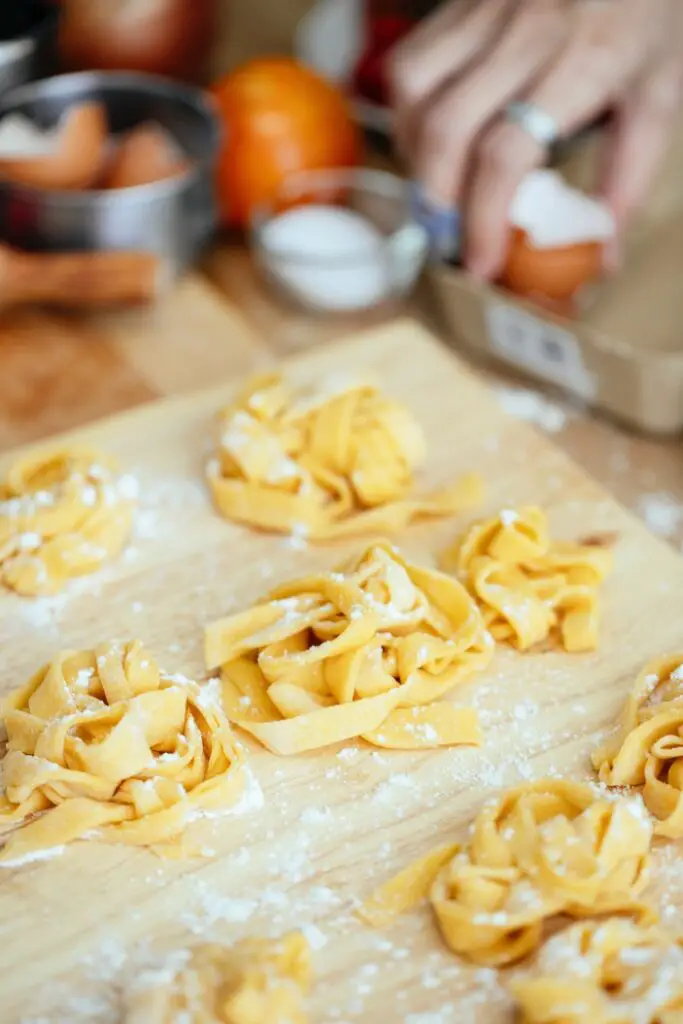
FAQ
Q: What is the recommended serving size of pasta per person?
A: The recommended serving size of pasta is typically about two ounces of dry pasta, which amounts to about a cup of cooked pasta.
Q: How much pasta should I plan for when feeding a crowd?
A: To ensure you have enough pasta for everyone, it’s recommended to plan for about one cup per four people. So if you’re serving a group of eight, you would need approximately two cups of dry pasta.
Q: How do I determine the amount of dry pasta to cook?
A: The amount of dry pasta to cook varies based on the type of pasta you’re using. Refer to our handy chart for the specific uncooked amount per person for various types of pasta.
Q: What is the sauce-to-pasta ratio I should follow?
A: For tomato-based sauces, use about 1 ½ cups of sauce for every pound of pasta. For oil-based sauces, use about one cup of sauce per pound of pasta. Creamy sauces like Alfredo should be used more sparingly based on personal taste.
Q: How do I prepare the pasta and sauce for the perfect combination?
A: Cook the pasta according to the package instructions. While the pasta is cooking, heat the sauce in a large pan until warm. Drain the cooked pasta, reserving about half a cup of pasta water. Add the pasta to the warmed sauce, along with a small amount of fat, and start with a quarter cup of reserved pasta water. Mix well for a creamy and well-coated pasta dish.
Q: Can I freeze leftover cooked pasta?
A: Yes, you can freeze leftover cooked pasta. It’s best to freeze the pasta and sauce separately to maintain the best quality.
Q: Are there any additional tips for pasta preparation?
A: Consider pairing your pasta with complementary sauces, saving pasta water as a thickening agent for pasta sauce, and adding a pinch of sugar to tomato-based sauces to balance the acidity.
Source Links
- https://thekitchenchalkboard.com/how-much-pasta-per-person/
- https://www.foodandthensome.com/how-much-pasta-to-make-per-person/
- https://www.tasteofhome.com/article/how-much-pasta/
Printable Recipe Card
Want just the essential recipe details without scrolling through the article? Get our printable recipe card with just the ingredients and instructions.

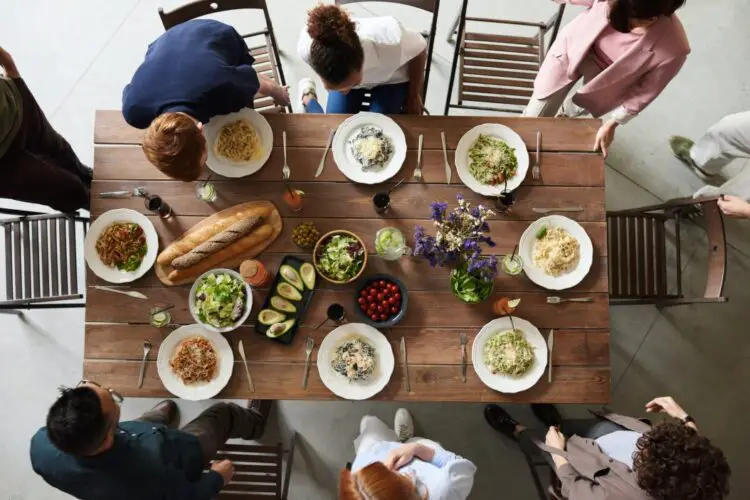
Pingback: How to Serve Enough Meatballs? Cooking for a crowd (50)